

Investigación Aplicada
Compressive strength and microstructure of concretes manufactured with supersulfated cement based on materials of volcanic origin exposed to a sulfate environment
Resistencia a la compresión y microestructura de concretos fabricados con cementos supersulfatados base materiales de origen volcánico expuestos a un ambiente de sulfato
Resistência à compressão e microestrutura do concreto fabricado com materiais à base de cimento supersulfatado de origem vulcânica expostos a um ambiente de sulfato
Compressive strength and microstructure of concretes manufactured with supersulfated cement based on materials of volcanic origin exposed to a sulfate environment
Revista de la Asociación Latinoamericana de Control de Calidad, Patología y Recuperación de la Construcción, vol. 9, no. 1, 2019
Asociación Latinoamericana de Control de Calidad, Patología y Recuperación de la Construcción, A. C.
Received: 12 December 2018
Accepted: 30 December 2018
Published: 30 December 2018
Abstract: This paper presents the results of concretes manufactured with supersulfated cement (SSC) based on volcanic materials. The concretes were cured under two regimes, one for 24 h at 25 °C and another for 22 h at 60 °C and then at 25 °C. The specimens were exposed to two conditions: dry laboratory conditions and immersed in a solution with 3.5% CaSO4 at 25 °C for up to 180 days. After 180 days, the concrete with a cementitious compound of 5%An-10%PC-10%CaO-75%PM reached a compressive strength of 46 MPa exposed to CaSO4 solution and of 44 MPa in dry laboratory conditions. The microstructure was analyzed by scanning electron microscopy, energy-dispersive X-ray spectroscopy and X-ray diffraction, which showed that the main hydration products are C-S-H and ettringite.
Keywords: supersulfated concrete, pumice, compressive strength, sulfate environment.
Resumen: Esta investigación presenta los resultados de concretos fabricados con cementos supersulfatados (SSC) bases materiales volcánicos. Los concretos fueron curados bajo dos regímenes uno por 24 h a 25°C y otro por 22 h a 60°C y luego a 25 °C. Los especímenes fueron expuestos a dos condiciones, en seco en condiciones de laboratorio e inmersos en una solución con 3.5% CaSO4 a 25°C hasta por 180 días. Después de 180 días, el concreto con un cementante compuesto de 5%An-10%PC-10%CaO-75%PM expuesto a la solución de CaSO4 alcanzó una resistencia a la compresión de 46 MPa y 44 MPa en seco en condiciones de laboratorio. La microestructura fue analizada por microscopia electrónica de barrido, espectroscopia por dispersión de energía y DRX, mostró que los principales productos de hidratación son C-S-H y etringita.
Palabras clave: concreto supersulfatado, pómez, resistencia a la compresión, ambiente de sulfato.
Resumo: Esta investigação apresenta resultados de concretos fabricados con cementos supersulfatados (SSC) bases materiales volcánicos. Os concretos fueron curados são regulados por 24 a 25 ° C e por 22 a 60 ° C e a 25 ° C. As especificações para a execução de testes de condições, em condições de trabalho e in vivo em uma solução de 3,5% CaSO4 a 25 ° C hasta por 180 dias. Depois de 180 días, o concreto com um componente compacto de 5% Um-10% de PC-10% de CaO-75% de PM expuesto para a solução de CaSO4 atingiu uma resistência à compressão de 46 MPa e 44 MPa em seco en condiciones de laboratorio. La microestructura fue analized por microscopia electronica de barreto, spectroscopia por dispersion de energía y DRX, mostrada que os principais produtos de hidratação são C-S-H e etringita.
Palavras-chave: concreto supersulfatado, pómez, resistencia a la compresión, ambiente de sulfato.
INTRODUCTION
Concrete is the most widely used composite material in the world, which implies that Portland cement (PC) is the construction material with the highest consumption and production, with an annual production of almost 2 billion tonnes, emitting approximately 2 billion tonnes of CO2 (Shi et al., 2011). The effort to reduce air pollution has led to the development and use of new environmentally friendly cementitious materials, such as supersulfated cements (SSC), due to their energy savings, low carbon emissions, and reuse of waste (Ding et al., 2014). These cements can reduce CO2 emissions up to 90% compared to PC (Woltron, 2009). The SSCs are commonly composed of granulated blast furnace slag, a sulfate source such as hemihydrate (HH) or anhydrite (An), and a small amount of alkaline activator, mainly clinker and PC (Kühl, 1908; Midgley and Pettifer, 1971; Bijen and Niël, 1981; Mehrotra et al., 1982; Dutta and Borthakur, 1990; Grounds et al., 1995; Taylor, 1998; Juenger et al., 2011) or calcium hydroxide and potassium hydroxide (Kamlet, 1960). Few investigations have studied SSCs composed of natural pozzolans (Cabrera-Luna et al., 2018).
The purpose of this research is to present a study of the mechanical properties and microstructure of concretes manufactured with SSC composed of pumice (PM). At 28 days of age, the concretes were exposed to dry laboratory conditions and immersed in a solution of 3.5% CaSO4. This study is part of research on volcanic-based SSC (Cabrera-Luna et al., 2018).
MATERIALS
Supersulfated cement is based on PM material of volcanic origin, with a surface area of 600 m2/kg, two sulfate sources—commercially available HH and industrial byproduct An—and two alkaline sources—Portland-composite cement PCC 30R (PC) (ONNCCE, 2014) and commercially available calcium oxide (CaO). Table 1 shows the chemical composition of the main oxides of the starting materials.
The fine aggregate was of volcanic origin with a fineness modulus of 2.84. The coarse aggregate had a maximum nominal size of 12.5 mm and a volumetric density of 1,388.54 kg/m3. A polycarboxylate-type superplasticizer was used to maintain the water/cement ratio of 0.30 and slump of 75 to 100 mm.
| Oxide %wt | SiO2 | Al2O3 | K2O | Na2O | Fe2O3 | CaO | MgO | SO3 | Other |
| PM | 68.73 | 14.01 | 5.45 | 3.69 | 2.50 | 1.64 | 0.34 | 3.64 | |
| An | 0.11 | 43.83 | 55.45 | 0.61 | |||||
| HH | 0.94 | 39.70 | 0.58 | 51.69 | 7.09 | ||||
| PC | 17.74 | 3.97 | 1.09 | 3.65 | 62.71 | 1.36 | 4.45 | 5.03 | |
| CaO | 87.68 | 0.35 | 0.83 | 11.14 |
EXPERIMENTAL PROCEDURE
Design of mixtures and manufacture of specimens
Four concrete mixtures were designed based on the procedure proposed by the absolute volume method, published by ACI 211.1 (ACI Committee 211, 2002) , with a water/binder ratio of 0.30, with regard to 720 kg/m3 of a cementitious material and a slump of 75 to 100 mm. Four different cementitious materials were used, composed of 1) 5%HH-20%PC-75%PM, 2) 15%HH-10%PC-10%CaO-65%PM, 3) 5%An-10%PC-10%CaO-75%PM, and 4) 15%An-20%PC-65%PM. Table 2 shows the quantity of cementitious compounds. A reference concrete was made with 100% PC (C-R).
For the compressive strength test, cubes 100 mm on each side were manufactured according to UNE-EN 12390-1 (AENOR, 2001). The concrete specimens had an initial curing treatment: one at 25 °C (T25) for 24 h and another at 60 °C for 22 h and then at 25 °C (T60) for the remainder of time.
After 28 days, the specimens were exposed to two environments: one in dry laboratory conditions at 25 °C (L) and another consisting of 7-day cycles immersed in a solution of 3.5% CaSO4 at 25 °C and then 7 days under laboratory conditions at 25 °C (S).
| Nomenclature | Pumice (PM) | Hemihydrate (HH) | Anhydrite (An) | Calcium oxide (CaO) | Portland cement (PC) |
| kg/m3 | |||||
| C-1 | 540 | 36 | - | - | 144 |
| C-2 | 468 | 108 | - | 72 | 72 |
| C-3 | 540 | - | 36 | 72 | 72 |
| C-4 | 468 | - | 108 | - | 144 |
| C-R | - | - | - | 415 | |
Characterization
The concrete compressive strength was determined up to 180 days by applying a load with a speed of 0.4 MPa/s according to the UNE-EN 12390-3 Standard (AENOR, 2003). Fragments of tested cubes were dried for 72 h in methanol and then in a vacuum chamber at 38 °C for 72 h. Later, fragments of dry cubes were mounted in resin, roughened, polished, and carbon-coated. These specimens were analyzed through a scanning electron microscope (Phillips model XL-30ESEM) operated at 20 kV.
RESULTS
Compressive strength
The reported values represent the average of three cubes. The evolution results of the concrete compressive strength for the curing regime of T25, exposed to dry laboratory conditions at 25 °C (L) and immersed in a solution of 3.5% CaSO4 at 25 °C (S) up to 180 days of age, are shown in Figure 1. At 28 days, it was observed that the C-2 concrete showed the lowest strength of 22 MPa; however, after 180 days, the strength increased, reaching approximately 41 MPa for both exposure conditions, higher than the value of the reference concrete. In contrast, the C-3 concrete reached the highest strength of approximately 44 MPa when exposed to the 3.5% CaSO4 solution, 24% higher than the reference concrete (C-R) at 180 days of age. The standard deviation values of the averages were ±0.10–2.30 MPa.
Figure 2 shows the compressive strength results of the specimens for the curing regime of T60, exposed to laboratory conditions at 25 °C and immersed in a solution of 3.5% CaSO4 at 25 °C. The compressive strength of the C-1 and C-3 concrete at 28 days reached values of approximately 32 MPa, similar to C-R; however, after 180 days of exposure to laboratory conditions, C-1 and C-3 reached approximately 42 and 44 MPa, respectively, higher than the reference concrete with 36 MPa, while C-3 immersed in a solution of 3.5% CaSO4 reached 46 MPa. The initial curing favored the initial and later strength in agreement with previous results (Cabrera-Luna et al., 2018). The standard deviation values of the averages were ±0.17–1.76 MPa.
In general, it was observed that the chemical composition and initial curing influenced the strength development according to previous results (Cabrera-Luna et al., 2018). These factors favorably influenced the densification of the matrix, providing resistance to the calcium sulfate (Grounds et al, 2003). However, the strength development of SSC is slower than that of the PC (Noor-ul-Amin, 2014) because the hydration process of SSC is slow at early ages, and then, the concrete compressive strength abruptly increases at advanced ages (Ding et al., 2014). The increase of compressive strength beyond 28 days may be related to the speed of the hydration products and the morphology of the formed plaster (Cabrera-Luna et al., 2018).
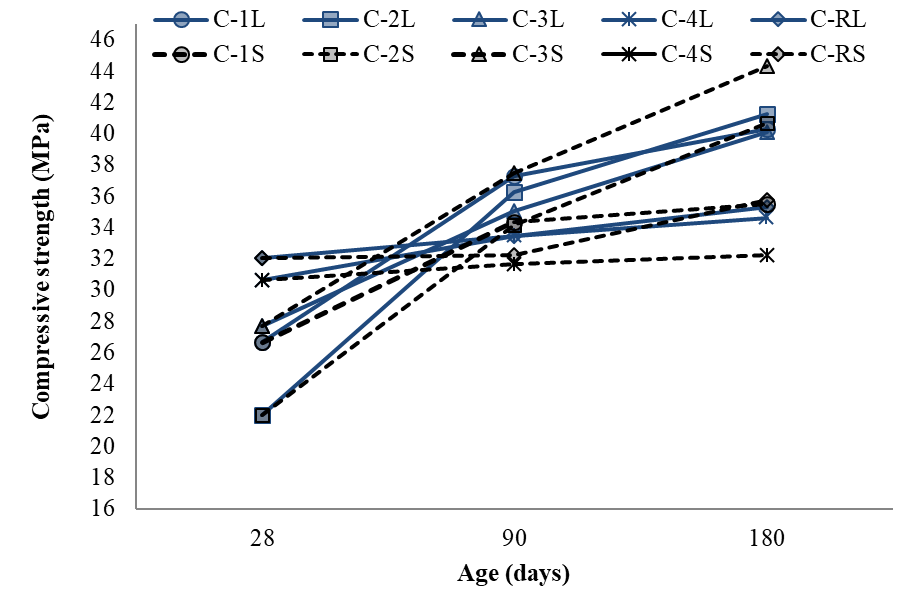
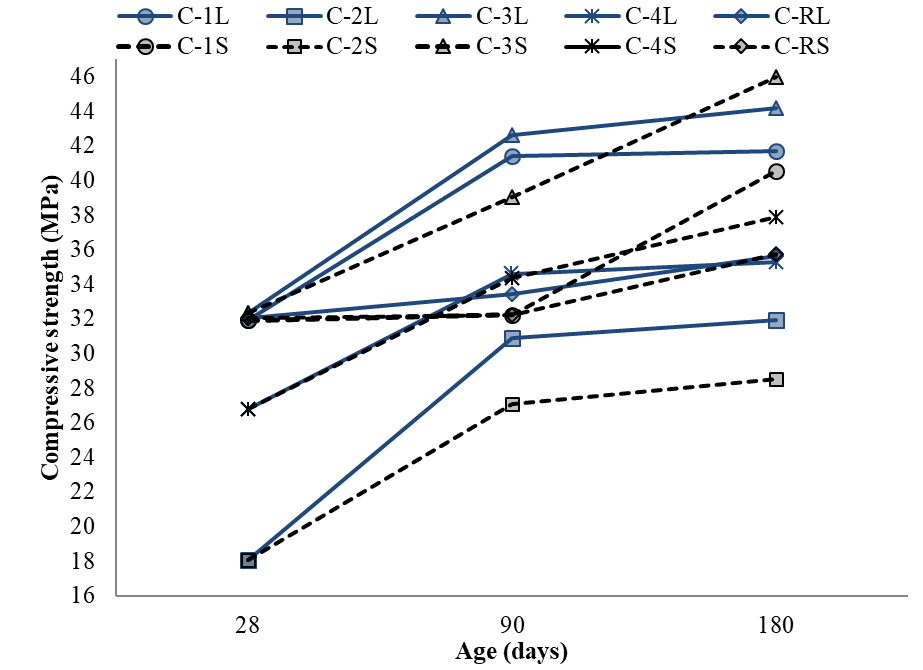
X-ray diffraction (XRD)
Figure 3 presents the XRD patterns of the PM and the cementitious compound of 15%An-20%PC -65%PM at 28 days, which was used to make the C-4 concrete. After the chemical activation of the PM at 28 days, the amorphous halo of the PM decreased in intensity and was slightly displaced to the right, suggesting that the PM particles reacted with the activators to form the hydration products, such as ettringite, An, gypsum, and C-S-H, identified as the primary hydrating phases. The An reflection peaks reveal low solubility and reactivity, which influenced a low amount of formed ettringite. This agrees with the presence of weak ettringite reflection peaks, suggesting that late-age strength development is mainly due to the formation of C-S-H according to (Cabrera-Luna et al., 2018).
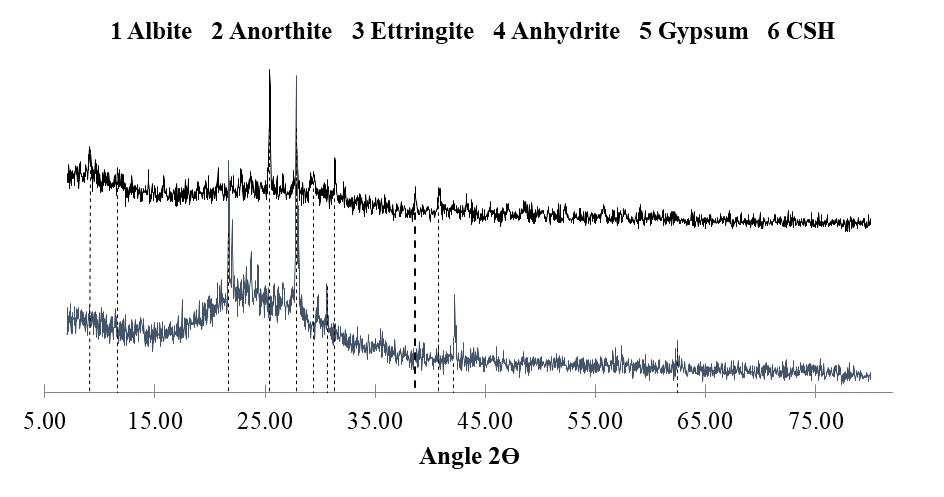
Scanning electron microscopy (SEM)
Figure 4 and Figure 5 show the microstructure of the C-3 concrete (5%An-10%PC-10%CaO-75%PM) for the T60 regime exposed to dry laboratory conditions at 25 °C (L) at 28 days and immersed in a 3.5% CaSO4 solution at 25 °C (S) at 90 days, respectively. The images were obtained using backscattered electrons. In all micrographs, PM particles identified by an irregular morphology of different sizes were observed, suggesting that not all particles reacted to form hydration products; moreover, due to their size, it is easy to distinguish aggregate particles embedded in the matrix of reaction products. An particles were not observed, suggesting that the Ca2+ and SO4 2- ions reacted with the alumina phase of the PM to form ettringite (Juenger et al., 2011; Sadique et al., 2012; Bazaldúa-Medellín et al., 2015; Gracioli et al., 2017; Rubert et al., 2018). In Figure 4, the absence of PC grains suggested that they reacted with water to form more Ca(OH)2, promoting the dissolution of PM to produce C-S-H and other products (Sadique et al., 2012). The microstructure was dense with cracks caused by the drying of the gel under the high vacuum conditions in the electron column of the microscope (Avila-López et al., 2015). In general, the matrix–aggregate interface is continuous; no cracks were observed in this area, showing good adherence. However, in the polished samples, the ettringite was difficult to detect; moreover, it easily decomposed under the high vacuum drying conditions of the electron column of the microscope (Bazaldúa-Medellín et al., 2015). Although the X-ray microanalysis spectra (EDS) allowed their identification, they showed that the primary hydration products of the SSC concretes were C-S-H and ettringite, distributed through the finely intermixed matrix. This agrees with (Cabrera-Luna et al., 2018). The presence of ettringite crystals provides strength instead of expansion (Sadique et al., 2012); these crystals were deposited in the air voids (Wolfe et al., 2001) initially occupied by water (Cabrera-Luna et al., 2018), densifying the matrix microstructure together with the C-S-H (Bazaldúa-Medellín et al., 2015) and improving the strength. Therefore, this phase was not accompanied by expansion (Wolfe et al., 2001), and there was no visible expansion in the concrete samples after 180 days. These results coincide with the XRD patterns.
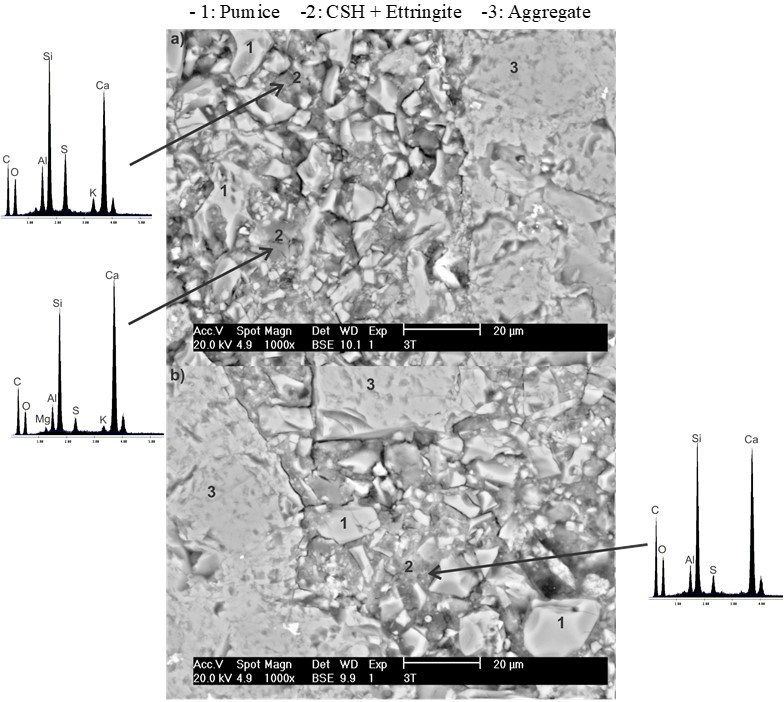
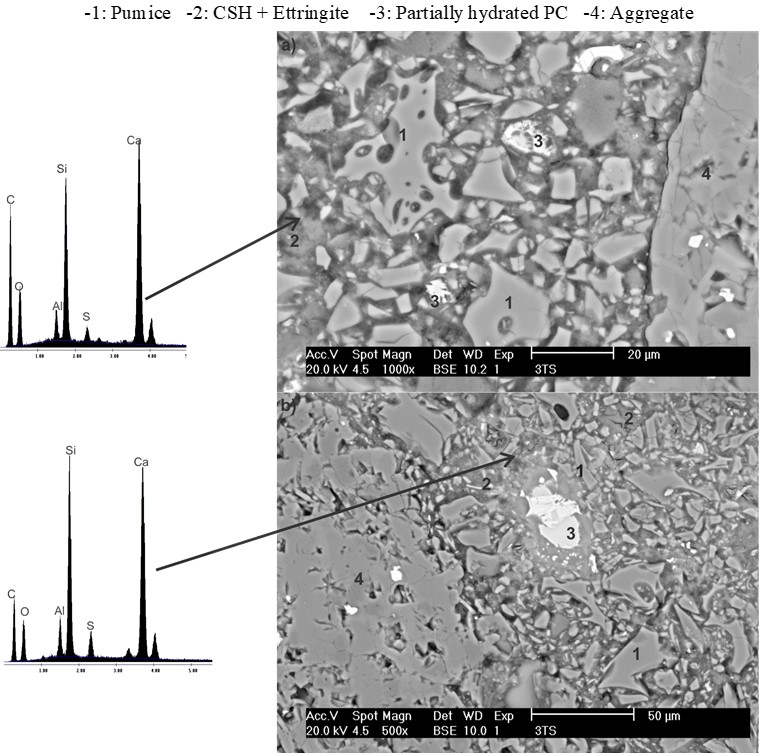
DISCUSSION
Concrete degradation by sulfate attack mechanisms depends on several factors, such as cement type, presence of mineral additions, water/cement ratio, cation type associated with sulfate anions, sulfate concentration, time and duration of exposure, environment, hydration degree, and curing conditions (Hossain and Lachemi, 2006; Prasad et al., 2006; Indu Siva Ranjani and Ramamurthy, 2012), in addition to other parameters, such as pore structure, permeability, diffusivity and mechanical properties (Prasad et al., 2006). In concretes made with PC, the degree of sulfate attack depends on the availability of Ca(OH)2 and C3A (Hossain and Lachemi, 2006); therefore, the chemical composition of the cement has an important role in its resistance to sulfate (Prasad et al., 2006). The SSCs of this investigation were based on volcanic PM, calcium sulfate and alkaline sources. When the SSCs were exposed to a calcium sulfate solution by means of hydrating and drying cycles, they increased in stability and strength, with stable microstructures. This suggests that the external sulfate ions did not have suitable conditions to decalcify the Ca(OH)2 or C-S-H. Moreover, the decrease in PC consumption reduced the amount of calcium aluminates, which had already found an abundant source calcium sulphate from the additives of the SSC, so these formed ettringite that stabilized as such; moreover, the low Al content from the PM and abundance of calcium sulphate also minimized the possibility of deleterious delayed ettringite. Nonetheless, the expansion does not only depend on the amount and time of formation of ettringite; the location of formation is also important (Wojceich, Marczewska and Jaworska, 1985); in this case, the nature of the microstructures, the rate of reaction of the components of the SSC, favored a sequence of reactions and deposition of reaction products that showed in a favorable balance that resulted in strong microstructures forming durable cements. On the other hand, the low water/binder ratio used must have had a positive effect, as it reduced the volume and connectivity of the porous network, which reduced the penetration of external agents (Indu Siva Ranjani and Ramamurthy, 2012).
In general, no physical degradation was noted during the period of study, such as cracking, spalling, loss of strength and adhesion. The concretes SSC seem suitable for use in marine conditions and for construction of sewage pipes
CONCLUSIONS
The compressive strength of specimens cured at 25 °C showed that the concretes made with cementitious compounds of 15%HH-10%PC-10%CaO-65%PM and 5%An-10%PC-10%CaO-75%PM reached approximately 41 and 44 MPa, respectively, when immersed in a solution of 3.5% CaSO4.
Supersulfated concretes with cementitious compounds of 5%HH-20%PC -75%PM, 5%An-10%PC-10%CaO-75%PM and 15%An-20%PC -65%PM cured at 60 °C showed greater strength than the reference concrete by up to 30% when immersed in a solution of 3.5% CaSO4.
The main hydration products of the supersulfated concretes detected by XRD, SEM and EDS were C-S-H and ettringite, which provided a favorable compressive strength when exposed to laboratory conditions and calcium sulfate.
Curing at 60 °C for 22 h favors early-age strength and late-age development, mainly in the samples exposed to sulfate in almost all concretes.
The microstructure of the concrete with a cementitious compound of 5%An-10%PC-10%CaO-75%PM showed unreacted PM particles and aggregates embedded in a paste structure of a relatively dense matrix.
In general, supersulfated concretes show favorable compressive strength values when exposed to a 3.5% CaSO4 solution, presenting adequate properties for use in marine environments.
Acknowledgements
The authors would like to thank the National Council of Science and Technology for the scholarship to K Luna-Cabrera and the Conacyt FC-2015-2 / 906 project for financial support.
REFERENCES
ACI Committee 211 (2002), Standard Practice for Selecting Proportions for Normal, Heavyweight, and Mass Concrete ( ACI 211.1-91 ).
AENOR (2001), UNE-EN 12390-1,Testing hardened concrete. Part 1: Shape, dimensions and other requirements for specimens and moulds.
AENOR (2003), UNE-EN 12390-3, Testing hardened concrete Part 3: Compressive strength of test specimens.
Avila-López, U., Almanza-Robles, J. M., Escalante-García, J. I. (2015), "Investigation of novel waste glass and limestone binders using statistical methods", Construction and Building Materials, 82, pp. 296–303. https://doi.org/10.1016/j.conbuildmat.2015.02.085
Bazaldúa-Medellín, M. E., Fuentes, A. F., Gorokhovsky, A., Escalante-García, J. I. (2015), "Early and late hydration of supersulphated cements of blast furnace slag with fluorgypsum", Materiale de Construcción, 65(317), p. e043. https://doi.org/10.3989/mc.2015.06013.
Bijen, J., Niël, E. (1981), "Supersulphated cement from blastfurnace slag and chemical gypsum available in the Netherlands and neighbouring countries", Cement and Concrete Research, 11(3), pp. 307–322. https://doi.org/10.1016/0008-8846(81)90104-6.
Cabrera-Luna, K., Maldonado-Bandala, E. E., Nieves-Mendoza, D., Escalante García, J. I. (2018), "Supersulfated binders based on volcanic raw material: Optimization, microstucture and reaction products", Construction and Building Materials, 176, pp. 145–155. https://doi.org/10.1016/j.conbuildmat.2018.05.024.
Ding, S., Shui, Z., Chen, W., Lu, J., Tian, F. (2014), "Properties of supersulphated phosphogysumslag cement (SSC) concrete", Journal Wuhan University of Technology, Materials Science Edition, 29(1), pp. 109–113. https://doi.org/10.1007/s11595-014-0876-9.
Dutta, D. K., Borthakur, P. C. (1990), "Activation of low lime high alumina granulated blast furnace slag by anhydrite", Cement and Concrete Research, 20(5), pp. 711–722, https://doi.org/10.1016/0008-8846(90)90005-I
Gracioli, B., Favero Varela, M. V., Beutle, C. S., Frare, A., Angulski da Luz, C., Pereira Filho, J. I. (2017), "Considerações sobre a resistência mecânica e o processo de hidratação de cimentos supersulfatados (CSS) formulados com fosfogesso", Matéria (Rio de Janeiro), 22(1). https://doi.org/10.1590/s1517-707620170001.0107.
Grounds, T., Nowell, D. V., Wilburn, F. W. (2003), "Resistance of supersulfated cement to strong sulfate solutions", Journal of Thermal Analysis and Calorimetry, 72(1), pp. 181–190. https://doi.org/10.1023/A:1023928021602.
Grounds, T., Nowell, D. V., Wilburn, F. W. (1995), "The influence of temperature and different storage conditions on the stability of supersulphated cement", Thermal Analysis, 45, pp. 385–394. https://doi.org/10.1007/BF02549342.
Hossain, K. M. A., Lachemi, M. (2006), "Performance of volcanic ash and pumice based blended cement concrete in mixed sulfate environment", Cement and Concrete Research, 36(6), pp. 1123–1133. https://doi.org/10.1016/j.cemconres.2006.03.010.
Indu Siva Ranjani, G., Ramamurthy, K. (2012), "Behaviour of foam concrete under sulphate environments", Cement and Concrete Composites. Elsevier Ltd, 34(7), pp. 825–834. https://doi.org/10.1016/j.cemconcomp.2012.03.007.
Juenger, M. C. G., Winnefeld, F., Provis, J. L., Ideker, J. H. (2011), "Advances in alternative cementitious binders", Cement and Concrete Research. Elsevier Ltd, 41, pp. 1232–1243. https://doi.org/10.1016/j.cemconres.2010.11.012.
Kamlet, J. (1960), "US2947643A Hydraulic Cements".
Kühl, H. (1908), "German Patent No. 237777". German.
Mehrotra, V. P., Sai, A. S. R., Kapur, P. C. (1982), "Plaster of Paris activated supersulphated slag cement", Cement and Concrete Research, 12(4), pp. 463–473. ttps://doi.org/10.1016/0008-8846(82)90061-8.
Midgley, H. G., Pettifer, K. (1971,) "The microstructure of hydrated super sulphated cement", Cement and Concrete Research, 1(1), pp. 101–104. https://doi.org/10.1016/0008-8846(71)90086-X.
Noor-ul-Amin (2014), "An overview on comparative study of alternatives for Ordinary Portland cement", Journal of Basic and Applied Chemistry, 4(6), pp. 15–22, ISSN 2090-424X
ONNCCE (2014), NMX-C-414-ONNCCE, Building industry - hydraulic cement -specifications and testing methods.
Prasad, J. et al. (2006), "Factors Influencing The Sulphate Resistance of Cement Concrete and Mortar", Asian Journal of Civil Engineering (Building and Housing), 7(3), pp. 259–268.
Quanlin, N., Rui, Z. (2015), "Experimental study on some properties of a low-carbon cement", in International Conference on Advances in Energy and Environmental Science, pp. 1440–1443.
Rubert, S., Angulski da Lu, C., Varela, M. V. F., Pereira Filho, J. I., Hooton, R. D. (2018), "Hydration mechanisms of supersulfated cement: The role of alkali activator and calcium sulfate content", Journal of Thermal Analysis and Calorimetry. Springer Netherlands, 134(2), pp. 971–980. https://doi.org/10.1007/s10973-018-7243-6.
Sadique, M., Nageim, H. A., Atherton, W., Seton, L., Dempster, N. (2012), "A new composite cementitious material for construction", Construction and Building Materials. Elsevier Ltd, 35, pp. 846–855. https://doi.org/10.1016/j.conbuildmat.2012.04.107.
Shi, C., Jiménez, A. F., Palomo, A. (2011), "New cements for the 21st century: The pursuit of an alternative to Portland cement", Cement and Concrete Research. Elsevier B.V., 41(7), pp. 750–763. https://doi.org/10.1016/j.cemconres.2011.03.016.
Taylor, H. F. W. (1998), Cement chemistry. 2nd edn, Cement and Concrete Composites. 2nd edn. Thomas Telford Publishing. https://doi.org/10.1016/S0958-9465(98)00023-7.
Wojceich, P., Marczewska, J., Jaworska, M. (1985), "Some Aspects and Mechanisms of sulphate attack", Structure, pp. 19–24.
Wolfe, W. E. et al. (2001), "The Effect of Ettringite Formation on Expansion Properties of Compacted Spray Dryer Ash", in International Ash Utilization Symposium.
Woltron, G. (2009), "The utlisation of GGBFS for advanced supersulfated cements", World Cement.
Author notes
erimaldonado@uv.mx
Additional information
Cite as: K. Cabrera Luna, J. I. Escalante García, D. Nieves
Mendoza, E. E. Maldonado Bandala (2019), “Compressive strength and microstructure of concretes manufactured with supersulfated cement based on materials of volcanic origin exposed to a sulfate environment”, Revista ALCONPAT, 9 (1), pp. 106 – 116,
DOI: http://dx.doi.org/10.21041/ra.v9i1.374
Legal Information: Revista ALCONPAT is a quarterly publication by the Asociación Latinoamericana de Control de Calidad,
Patología y Recuperación de la Construcción, Internacional, A.C., Km. 6 antigua
carretera a Progreso, Mérida, Yucatán, 97310, Tel.5219997385893, alconpat.int@gmail.com,
Website: www.alconpat.org
Responsible editor: Pedro
Castro Borges, Ph.D. Reservation of rights for exclusive use
No.04-2013-011717330300-203, and ISSN 2007-6835, both granted by the Instituto
Nacional de Derecho de Autor. Responsible for the last update of this issue,
Informatics Unit ALCONPAT, Elizabeth Sabido Maldonado, Km. 6, antigua carretera a Progreso, Mérida, Yucatán, C.P. 97310.
The views of the authors do
not necessarily reflect the position of the editor.
The total or partial
reproduction of the contents and images of the publication is strictly
prohibited without the previous authorization of ALCONPAT Internacional
A.C.
Any dispute, including the
replies of the authors, will be published in the third issue of 2019 provided
that the information is received before the closing of the second issue of 2019.